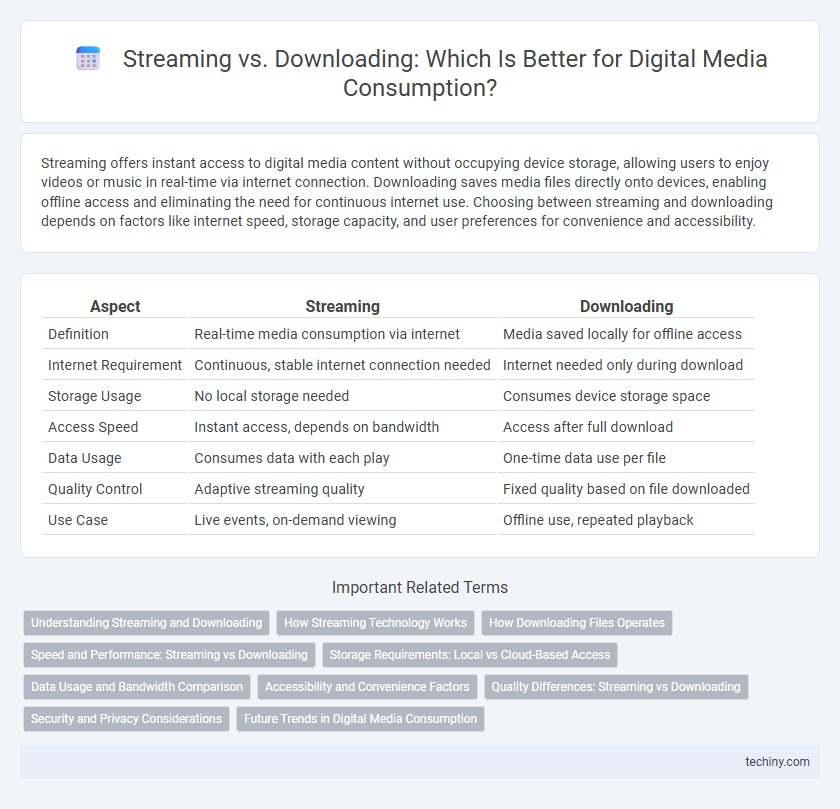Streaming offers instant access to digital media content without occupying device storage, allowing users to enjoy videos or music in real-time via internet connection. Downloading saves media files directly onto devices, enabling offline access and eliminating the need for continuous internet use. Choosing between streaming and downloading depends on factors like internet speed, storage capacity, and user preferences for convenience and accessibility.
Table of Comparison
| Aspect | Streaming | Downloading |
|---|---|---|
| Definition | Real-time media consumption via internet | Media saved locally for offline access |
| Internet Requirement | Continuous, stable internet connection needed | Internet needed only during download |
| Storage Usage | No local storage needed | Consumes device storage space |
| Access Speed | Instant access, depends on bandwidth | Access after full download |
| Data Usage | Consumes data with each play | One-time data use per file |
| Quality Control | Adaptive streaming quality | Fixed quality based on file downloaded |
| Use Case | Live events, on-demand viewing | Offline use, repeated playback |
Understanding Streaming and Downloading
Streaming delivers digital content in real-time over the internet, allowing users to access audio, video, or games without storing files locally. Downloading transfers the entire file to a device, enabling offline access but requiring storage space and longer waiting times. Understanding these differences helps optimize bandwidth usage and enhances user experience based on connectivity and device capabilities.
How Streaming Technology Works
Streaming technology delivers digital content by transmitting data in real-time through continuous data packets over the internet, allowing users to access media instantly without waiting for a full download. It relies on protocols like HTTP Live Streaming (HLS) and Dynamic Adaptive Streaming over HTTP (DASH) to adjust video quality dynamically based on network conditions. This method reduces storage demands on user devices and enables seamless playback by buffering small segments of content just ahead of viewing.
How Downloading Files Operates
Downloading files in digital media involves transferring data from a remote server directly onto a user's device, enabling offline access without requiring continuous internet connectivity. This process uses protocols such as HTTP or FTP to retrieve complete media files, ensuring permanent storage on local devices. Unlike streaming, downloading requires waiting for the entire file transfer before playback can begin, which impacts initial user experience but provides flexibility in future usage.
Speed and Performance: Streaming vs Downloading
Streaming offers immediate access to content by delivering data in real-time, minimizing wait times but relying heavily on stable, high-speed internet connections for optimal performance. Downloading transfers the entire file to a device before access, which can take longer upfront but allows for smoother playback without interruptions once completed. Speed and performance depend on factors like bandwidth, file size, and network stability, with streaming favoring continuous data flow and downloading benefiting from complete file availability.
Storage Requirements: Local vs Cloud-Based Access
Streaming requires minimal local storage as content is accessed in real-time from cloud servers, enabling instant playback without storing large files on devices. Downloading demands significant local storage capacity since entire files must be saved for offline access, which can quickly consume device memory. Cloud-based streaming offers flexible access across multiple devices without storage constraints, while downloading limits usage to specific devices where content is saved.
Data Usage and Bandwidth Comparison
Streaming consumes continuous data based on playback duration and quality, often requiring higher bandwidth to avoid buffering, while downloading uses a fixed amount of data upfront, enabling offline access without ongoing bandwidth demands. Video streaming at 1080p typically uses 3-7 GB per hour, whereas downloading the same content uses equivalent data but only once. Efficient bandwidth management is crucial for streaming to maintain smooth playback, whereas downloading shifts data usage to an initial burst, reducing internet strain during consumption.
Accessibility and Convenience Factors
Streaming offers instant access to vast libraries of digital media without requiring storage space, enabling users to watch or listen from any device with an internet connection. Downloading provides offline accessibility, allowing uninterrupted use regardless of network availability, which is crucial in areas with unstable internet. The choice between streaming and downloading hinges on balancing immediate convenience with long-term accessibility needs.
Quality Differences: Streaming vs Downloading
Streaming quality depends heavily on internet speed and can fluctuate, often resulting in variable resolution and buffering issues. Downloading provides consistent high-quality playback since the entire media file is stored locally, enabling access to full-resolution content without interruption. For users prioritizing superior video and audio fidelity, downloading offers a more reliable and stable experience compared to streaming.
Security and Privacy Considerations
Streaming reduces the risk of data breaches by minimizing file storage on personal devices, while downloading exposes users to potential malware embedded in files. Encrypted streaming services offer enhanced privacy protections by securing data transmission between servers and clients. Users should evaluate platform security protocols and privacy policies to safeguard personal information during digital media consumption.
Future Trends in Digital Media Consumption
Streaming technology dominates digital media consumption with cloud-based platforms offering instant access to vast libraries and personalized content algorithms. Emerging 5G networks and edge computing will enhance streaming quality and reduce latency, driving real-time, interactive experiences like virtual concerts and augmented reality integration. Downloading remains relevant for offline access but is expected to decline as high-speed connectivity and adaptive streaming protocols improve seamless media delivery.
Streaming vs Downloading Infographic

 techiny.com
techiny.com